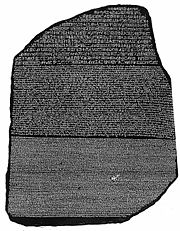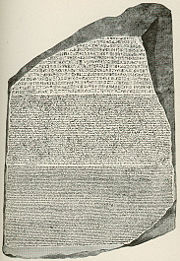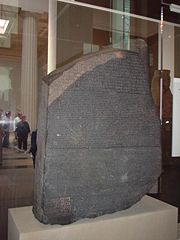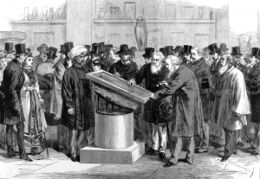Rosetta Stone
2008/9 Schools Wikipedia Selection. Related subjects: Archaeology
The Rosetta Stone is an Ancient Egypt ian artifact (حجر رشيد in Arabic) which was instrumental in advancing modern understanding of hieroglyphic writing. The stone is a Ptolemaic era stele with carved text. The text is made up of three translations of a single passage, written in two Egyptian language scripts (hieroglyphic and Demotic), and in classical Greek. It was created in 196 BC, discovered by the French in 1799 at Rashid (a harbour on the Mediterranean coast in Egypt which the French referred to Rosetta during Napoleon Bonaparte's campaign in Egypt) and contributed greatly to the decipherment of the principles of hieroglyphic writing in 1822 by the British polymath Thomas Young and the French scholar Jean-François Champollion. Comparative translation of the stone assisted in understanding many previously undecipherable examples of hieroglyphic writing. The text of the Rosetta Stone is a decree from Ptolemy V, describing the repealing of various taxes and instructions to erect statues in temples.
The Stone is 114.4 centimeters (45 in) high at its tallest point, 72.3 centimeters (28.5 in) wide, and 27.9 centimeters (11 in) thick. Weighing approximately 760 kilograms (1,676 lb), it was originally thought to be granite or basalt but is currently described as granodiorite and is dark blue-pinkish-grey in colour. The stone has been on public display at The British Museum since 1802.
History
Creation
The Rosetta Stone is a well-known example from a series of decrees, the Ptolemaic Decrees, issued by the Hellenistic Ptolemaic dynasty, which ruled Egypt from 305 BC to 30 BC. The series consists of the Decree of Canopus by Ptolemy III, Decree of Memphis, (as represented by the Memphis Stele) by Ptolemy IV, and the Rosetta Stone decree by Ptolemy V. Copies of the Ptolemaic Decrees were erected in several temple courtyards, as the decrees specified.
Modern-era Discovery
After Napoleon's 1798 conquest of Egypt, the French founded Institut de l'Égypte in Cairo, bringing 167 scientists and archaeologists to the region. French Army engineer Captain Pierre-François Bouchard discovered the stone sometime in mid-July 1799 (the sources are unfortunately not more specific), while guiding construction work at Fort Julien near the Egyptian port city of Rashid ( Rosetta). The Napoleonic army was so awestruck by this unheralded spectacle that, according to a witness, "it halted of itself and, by one spontaneous impulse, grounded its arms." (As quoted by Robert Claiborne, The Birth of Writing [1974], p. 24.) He understood that it was important and showed it to General Jacques de Menou. They sent it to the Institut de l'Égypte, where it arrived in August. The French language newspaper Courrier de l'Egypte announced the find in September.
After Napoleon returned to France in 1799, 167 scholars remained behind with French troops which held off British and Ottoman attacks. In March 1801, the British landed on Aboukir Bay and scholars carried the Stone from Cairo to Alexandria alongside the troops of de Menou. French troops in Cairo capitulated on June 22, and in Alexandria on August 30.
After the surrender, a dispute arose over the fate of French archaeological and scientific discoveries in Egypt. De Menou refused to hand them over, claiming that they belonged to the Institute. British General John Hely-Hutchinson, 2nd Earl of Donoughmore, refused to relieve the city until de Menou gave in. Newly arrived scholars Edward Daniel Clarke and William Richard Hamilton agreed to check the collections in Alexandria and found many artifacts that the French had not revealed.
When Hutchinson claimed all materials as a property of the British Crown, a French scholar Étienne Geoffroy Saint-Hilaire, said to Clarke and Hamilton that they would rather burn all their discoveries, ominously referring to the burned Library of Alexandria. Hutchinson finally agreed that items such as the biology specimens would be the scholars' private property. De Menou regarded the stone as his private property and hid it.
How exactly the Stone came to British hands is disputed. Colonel Tomkyns Hilgrove Turner, who escorted the stone to Britain, claimed later that he had personally seized it from de Menou and carried it away on a gun carriage. Clarke stated in his memoirs that a French scholar and an officer had quietly given up the stone to him and his companions in a Cairo back street. French scholars departed later with only imprints and plaster casts of the stone.
Turner brought the stone to Britain aboard the captured French frigate L'Egyptienne in February 1802. On March 11, it was presented to the Society of Antiquaries of London. Later it was taken to the British Museum, where it remains. White painted inscriptions on the artifact state "Captured in Egypt by the British Army in 1801" on the left side and "Presented by King George III" on the right.
Translation
In 1814, the Briton Thomas Young finished translating the enchorial ( demotic) text, and began work on the hieroglyphic script. From 1822 to 1824, Jean-François Champollion greatly expanded on this work, and he is known as the translator of the Rosetta Stone. Champollion could read both Greek and Coptic, and figured out what the seven Demotic signs in Coptic were. By looking at how these signs were used in Coptic, he worked out what they meant. Then he traced the Demotic signs back to hieroglyphic signs. By working out what some hieroglyphs stood for, he made educated guesses about what the other hieroglyphs meant.
In 1858, the Philomathean Society of the University of Pennsylvania published the first complete English translation of the Rosetta Stone. Three undergraduate members, Charles R Hale, S Huntington Jones, and Henry Morton, made the translation. The translation quickly sold out two editions and was internationally hailed as a monumental work of scholarship. In 1988, the British Museum bestowed the honour of including the Philomathean Rosetta Stone Report in its select bibliography of the most important works ever published on the Rosetta Stone. The Philomathean Society maintains a full-scale mold of the stone in its meeting room at the University of Pennsylvania.
Recent History
The Rosetta Stone has been exhibited almost continuously in the British Museum since 1802. Toward the end of World War I, in 1917, the Museum was concerned about heavy bombing in London and moved the Rosetta Stone to safety along with other portable objects of value. The Stone spent the next two years in a station on the Postal Tube Railway 50 feet below the ground at Holborn.
The Stone left the British Museum again in October 1972 to be exhibited for one month at the Louvre Museum on the 150th anniversary of the decipherment of hieroglyphic writings with the famous Lettre a M Dacier of Jean-François Champollion.
In July 2003, Egypt demanded the return of the Rosetta Stone. Dr. Zahi Hawass, secretary general of the Supreme Council of Antiquities in Cairo, told the press: "If the British want to be remembered, if they want to restore their reputation, they should volunteer to return the Rosetta Stone because it is the icon of our Egyptian identity." In 2005, Hawass was negotiating for a three-month loan, with the eventual goal of a permanent return. In November 2005, the British Museum sent him a replica of the stone.
Abbreviated-synopsis in English (eighth of text)
In the reign of the new king who was Lord of the diadems, great in glory, the stabilizer of Egypt, and also pious in matters relating to the gods, superior to his adversaries, rectifier of the life of men, Lord of the thirty-year periods like Hephaestus the Great, King like the Sun, the Great King of the Upper and Lower Lands, offspring of the Parent-loving gods, whom Hephaestus has approved, to whom the Sun has given victory, living image of Zeus, Son of the Sun, Ptolemy the ever-living, beloved by Ptah;
In the ninth year, when Aëtus, son of Aëtus, was priest of Alexander and of the Savior gods and the Brother gods and the Benefactor gods and the Parent-loving gods and the god Manifest and Gracious; Pyrrha, the daughter of Philinius, being athlophorus for Bernice Euergetis; Areia, the daughter of Diogenes, being canephorus for Arsinoë Philadelphus; Irene, the daughter of Ptolemy, being priestess of Arsinoë Philopator: on the fourth of the month Xanicus, or according to the Egyptians the eighteenth of Mecheir.
THE DECREE: The high priests and prophets, and those who enter the inner shrine in order to robe the gods, and those who wear the hawk's wing, and the sacred scribes, and all the other priests who have assembled at Memphis before the king, from the various temples throughout the country, for the feast of his receiving the kingdom, even that of Ptolemy the ever-living, beloved by Ptah, the god Manifest and Gracious, which he received from his Father, being assembled in the temple in Memphis this day, declared: Since King Ptolemy, the ever-living, beloved by Ptah, the god Manifest and Gracious, the son of King Ptolemy and Queen Arsinoë, the Parent-loving gods, has done many benefactions to the temples and to those who dwell in them, and also to all those subject to his rule, being from the beginning a god born of a god and a goddess—like Horus, the son of Isis and Osirus, who came to the help of his Father Osirus; being benevolently disposed toward the gods, has concentrated to the temples revenues both of silver and of grain, and has generously undergone many expenses in order to lead Egypt to prosperity and to establish the temples... the gods have rewarded him with health, victory, power, and all other good things, his sovereignty to continue to him and his children forever.
The complete Greek text, in English, is about 1600–1700 words in length, and is about 20 paragraphs long (average 80 words/paragraph).
Idiomatic use
The term Rosetta Stone has become idiomatic as something that is a critical key to a process of decryption or translation of a difficult problem. For example, "the Rosetta Stone of immunology" and " Arabidopsis, the Rosetta Stone of flowering time (fossils)".
An algorithm for predicting protein structure from sequence is named Rosetta@home. It makes its predictions by looking at existing protein structure data.
"Rosetta" is also of a "lightweight dynamic translator" distributed for Mac OS X by Apple. Rosetta enables applications compiled for a RISC processor ( PowerPC) to run on Apple systems using a CISC ( x86) processor.
Rosetta Stone (software) is also a brand of language learning software.
In molecular biology, a series of "Rosetta" bacterial cell lines have been developed that contain a number of tRNA genes that are rare in E. coli but common in other organisms, enabling the efficient translation of DNA from those organisms in E. coli.



